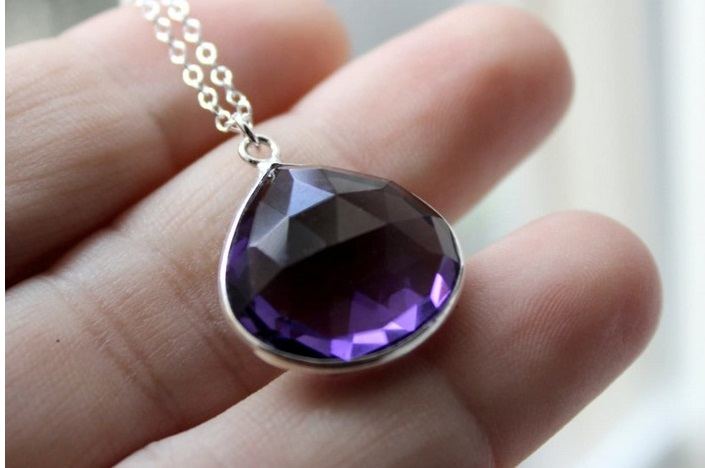Amethyst necklaces, as cherished pieces of jewelry, often captivate individuals with their stunning purple hues and mystical aura. When determining the price of such a necklace, numerous factors come into play. Among these, the origin of the amethyst stands out as a significant consideration. This article aims to delve into the relationship between the price of an amethyst necklace and its origin from a professional jewelry appraisal perspective, adopting a logical, reasonable, and popular science style.
Overview of Amethyst Origins
Amethyst, a member of the quartz family, is renowned for its distinctive purple coloration that ranges from light lavender to deep violet. This gemstone is found in various parts of the world, each with its unique geological characteristics that influence the quality, color, and rarity of the amethyst. Notable origins include Brazil, Uruguay, Zambia, and Madagascar, among others.
Geological Factors
The geological conditions in different regions significantly impact the formation and quality of amethyst. For instance, amethyst from Brazil is often praised for its rich, vibrant purple hues and excellent clarity. In contrast, amethyst from other regions may exhibit different color intensities or inclusions that affect its overall appearance and value. These geological differences contribute to the distinctiveness of amethyst from various origins and, consequently, influence their pricing.
Mining and Production Costs
The cost of mining and producing amethyst also varies by origin. In some regions, the mining process may be more challenging due to the geological structure, requiring advanced technology and higher labor costs. These expenses are reflected in the final price of the amethyst necklace. Additionally, the availability and accessibility of the amethyst deposits can affect the supply and, subsequently, the pricing dynamics.
The Influence of Origin on Amethyst Quality
The origin of an amethyst directly impacts its quality, which is a crucial determinant of its price. Several aspects of quality are influenced by the gemstone’s origin:
Color
Color is the most prominent factor affecting the value of amethyst. The ideal amethyst displays a saturated, even purple hue without significant color zoning or inclusions. Different origins produce amethyst with varying color characteristics. For example, Brazilian amethyst is known for its deep, vivid purple, while amethyst from Uruguay may have a lighter, more lavender tone. The preference for color can vary among consumers, but generally, deeper, more vibrant purples are more highly valued.
Clarity
Clarity refers to the presence or absence of internal and external flaws in the amethyst. Like other gemstones, amethyst can have inclusions such as cracks, bubbles, or other minerals. The clarity of amethyst is influenced by its origin, with some regions producing stones with fewer inclusions and higher transparency. High clarity amethyst is more desirable and, therefore, more expensive.
Cut and Craftsmanship
Although the origin does not directly dictate the cut and craftsmanship of an amethyst, it can indirectly affect these aspects. Some origins may have a longer tradition of gemstone cutting and polishing, resulting in more skilled craftsmen and higher quality cuts. A well-cut amethyst will maximize its brilliance and beauty, thereby increasing its value.
Market Dynamics and Rarity
The market for amethyst, like any other gemstone market, is subject to supply and demand dynamics. The rarity of amethyst from certain origins can significantly impact its price.
Supply and Demand
If amethyst from a particular origin is scarce due to limited deposits or difficult mining conditions, its price will naturally be higher. Conversely, if amethyst from another origin is abundant and easily accessible, it will be more affordable. The supply and demand balance is constantly shifting, and jewelry appraisers must stay updated on these market trends to accurately assess the value of amethyst necklaces.
Consumer Preferences and Trends
Consumer preferences and fashion trends also play a role in determining the price of amethyst necklaces. At times, amethyst from a specific origin may become particularly popular due to its unique color or association with a certain cultural or fashion trend. This increased demand can drive up the price of amethyst from that origin.
Appraisal Considerations
When appraising an amethyst necklace, jewelry appraisers take into account multiple factors, with origin being just one of them. Here are some key considerations in the appraisal process:
Documentation and Provenance
Knowing the origin of the amethyst can provide valuable information about its quality and rarity. Appraisers often rely on documentation such as certificates of authenticity or geological reports to verify the origin of the gemstone. This documentation can significantly impact the appraised value of the necklace.
Comparison with Similar Gemstones
Appraisers compare the amethyst in question with similar gemstones that have been sold recently to determine its market value. This comparison takes into account factors such as color, clarity, cut, and origin. By analyzing these similarities and differences, appraisers can arrive at a fair and accurate assessment of the amethyst necklace’s worth.
Condition and Maintenance
The condition of the amethyst necklace, including any damage or wear, will also affect its price. Appraisers will inspect the necklace for chips, cracks, or other imperfections that may detract from its value. Additionally, the maintenance history of the necklace, such as regular cleaning and professional repairs, can provide insight into its overall condition and, therefore, its price.
Conclusion
The price of an amethyst necklace is indeed related to its origin. The geological conditions, mining costs, quality characteristics, market dynamics, and consumer preferences all contribute to the pricing of amethyst necklaces. As a professional jewelry appraiser, understanding these factors is crucial in accurately assessing the value of amethyst necklaces and providing clients with reliable and informed appraisals.
Related topic:
- Amethyst Halo Crystal vs Ordinary Amethyst: What Is the Difference?
- Where is the Best Place to Find Amethyst?
- Where to Find Raw Amethyst?


